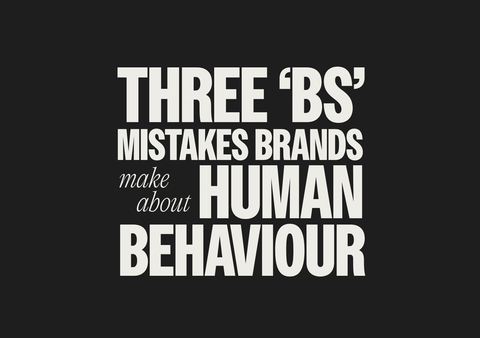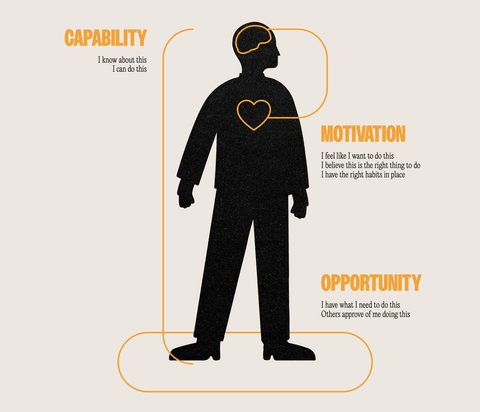NEWS ALERT - We won a SILVER IPM award for Best use of Social Media, 2025! Read more🏆

By now you should know that we're all about BS (behavioural science) here at Together. We use this to build our clients’ brilliant brands and marketing campaigns that resonate with their audiences and leave a lasting impression. We decided to dig deeper into where brands may be going wrong when it comes to human behaviour and pulled out three common points we believe brands are missing. Ultimately, it comes down to the ‘COM-B’ model; if that doesn’t mean anything to you yet, let us explain further.
Firstly let's talk about what the COM-B model actually is. COM-B stands for Capability (C), Opportunity (O), and Motivation (M) as the three key factors capable of changing Behaviour (B).
This model is a fairly modern theory developed in 2011 from research led by British psychologist Prof Susan Michie and her colleagues. The model was created as a tool to help diagnose barriers to behaviour change. We believe that if you follow and approach decisions within your brand following these three factors, you can steer your marketing strategies to disrupt behaviour and connect with your audience on a deeper level than competing campaigns. Head over to our blog where we explain more about the COM-B model with one of our behavioural psychologists, Dr Sara Bru Garcia.
Capability refers to an individual's psychological or physical ability to be able to interact or take part in or with the desired subject. The question ‘does the audience have the knowledge and/or skills to interact with this brand and its products?’ should be right at the top of the list when crafting a strategy. Before it even comes to branding and marketing the product, it needs to be usable and directly benefit the lives of the target customer.
This sounds simple enough. However, if you think about capability in terms of marketing, we need to think more about the psychology behind it and how to grab the audience's attention. Did you know that human short-term memory can only store about 7 items at one time and our average attention span is just 8.25 seconds?
With limited processing power, and an ever-decreasing attention span, ensuring you keep your messaging short & sweet is vital. Even for more complex products or services, it’s always worth boiling down your core message to its most important components before only leading with those. To overcomplicate things is to risk moving your message outside of the capability of your audience to engage.
Thinking about the usability of your product or service and how to therefore present your brand in marketing is the key here. Producing materials that audiences can access & engage with is always the main aim, but also you want to focus on making your content easy to absorb by creating a seamless user journey throughout your funnel.
Capability directly influences motivation; if your messaging, marketing and product are too complicated, your audience will lack the motivation to bother with the brand. So sometimes it may be best to stick to the three S’s - Short, Sweet and Simple. (If you’re thinking “the three S’s” is one acronym too many, we promise that’s the last one for today!)
Imagine you’ve bought a car with top-of-the-range heated seats… But you live in Dubai. Feels a tad unnecessary as you won’t ever have the opportunity to enjoy them, right?
A lot of what brands do revolves around the physical context of the product/service that's being sold. Within this, many fail to think about the social context and whether the product or service will have the opportunity to serve its audience in the intended way or place. Also, you need to think about the timing and cost.
Another example is a fitness brand that is looking to help people have the opportunity to exercise regularly. It’s unlikely that someone can go from doing nothing on their sofa to training regularly. Their body won’t necessarily be ready, and a gym membership can be quite a financial commitment. The easiest way to give them an opportunity to build up confidence and dedicated time is by offering a free trial. Giving the audience the opportunity to try out how this product can fit into their life could be a game changer for your brand.
So, depending on your brand and what you are offering the audience, you need to think about how and if the consumers are going to be able to use your offering. Also, when it comes to marketing, you need to think about the timings of when you're reaching your audience, and whether they will have the chance to digest your marketing efforts. If you want to target mothers you may think during school hours are the best time to target them as they have dropped the kids at school, they may be running other errands or at work but they will have more of an opportunity to take in the information and not be distracted as easily.
Just like capability, opportunity influences a person's motivation to do something. If they are unable to access your product or service then the most common thing for someone to do is ‘give up’.

So far, we’ve referenced motivation a few times in this piece. Humans are creatures of habit; we may hate to admit it, but that is just how we are. Many brands like to plot their audience as rational, driven & thoughtful data points. However, in reality, a lot of the time, humans will simply revert back to what they know best when faced with a challenge.
It's hard to disturb the rhythm of normal life; brands have been battling routine for decades through clever advertisement strategies. If suitable, don’t be afraid to jump right into this ‘battle’ and show how your brand's services or products will slot right into your audience’s life. Not every offering needs to change the world or flip the status quo.
With that said, for some brands, you will need to encourage behavioural change for your product to become part of a routine.
When trying to motivate a behavioural change, our favourite analogy is the ‘rumble strips’ you’ll encounter when driving. As you come to a junction or roundabout, the strips subconsciously encourage you to slow down. Take this as a great example of an environmental change to disrupt routine & encourage certain behaviour.
Consider giving your consumers physical prompts to help change their behaviour and impact their motivation to do something. For example, for the campaign “Couch to 5k”, the NHS offer gives you a week-by-week breakdown of how to go from never running at all to running 5k in just 9 weeks, they give you tips, tricks and how to get started. Without this assistance, the majority of people would likely give up from lack of motivation, but, with the NHS’ input, their campaign has seen continued successful execution.
In short, the main aim is to give your audience all the information and resources to dive straight in with your brand without any hiccups. By focusing on what motivates them, you’ll be armed with the critical requirements to create the most seamless & effective experience for your audience.
COM-B is the key to breaking the barriers for your brand. Focusing on these three drivers allows brands to put their products in front of their audience and encourage their desired behaviour.
Deeply understanding your audience will give you the best opportunity to influence behaviour; applying the COM-B model will help you turn that understanding into actionable considerations for your next campaign.
_____
At Together, we don’t just create or refresh brands; we use a blend of creative teams mixed with behavioural insights to produce content that connects with consumers on an emotional level and leaves a lasting impression.
If you’re looking to rebrand or want to spice up your campaigns in 2023, contact us today. We’d love to work on it, together.